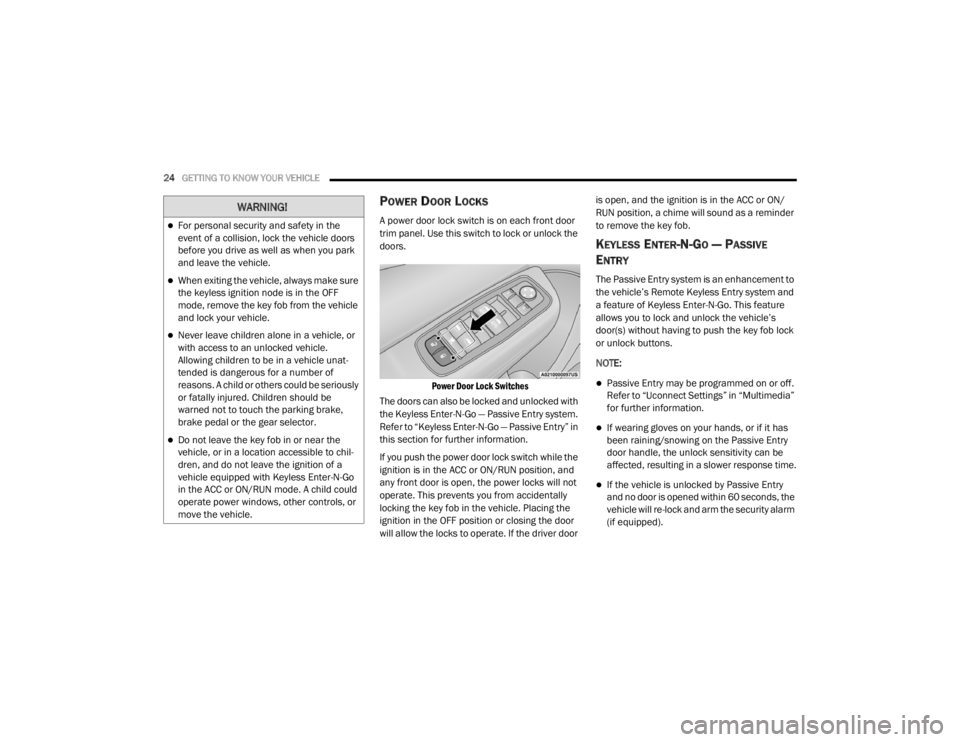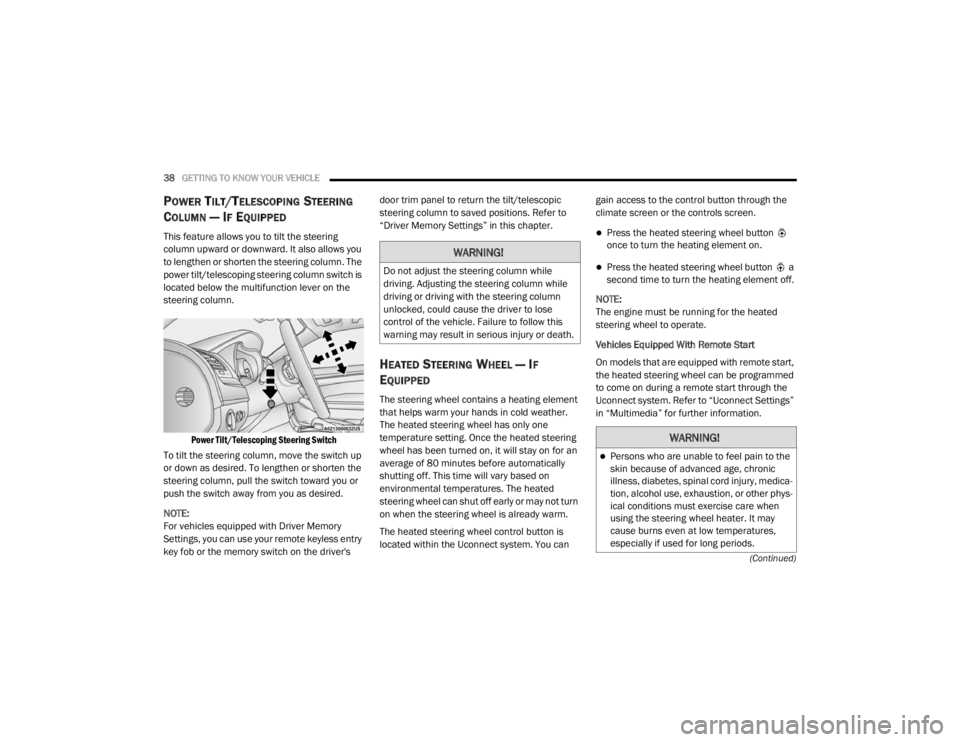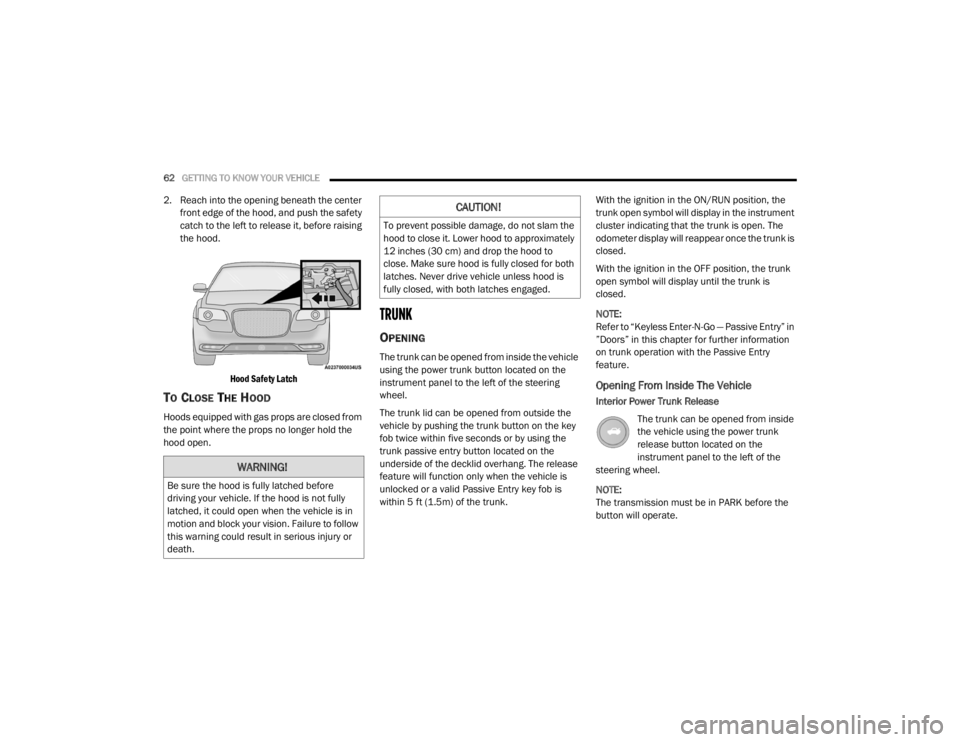2020 CHRYSLER 300 keyless entry
[x] Cancel search: keyless entryPage 24 of 328

22GETTING TO KNOW YOUR VEHICLE
GENERAL INFORMATION
The following regulatory statement applies to all
Radio Frequency (RF) devices equipped in this
vehicle:
This device complies with Part 15 of the FCC
Rules and with Innovation, Science and
Economic Development Canada license-exempt
RSS standard(s). Operation is subject to the
following two conditions:
1. This device may not cause harmful
interference, and
2. This device must accept any interference received, including interference that may
cause undesired operation.
Le présent appareil est conforme aux CNR
d`Innovation, Science and Economic
Development applicables aux appareils radio
exempts de licence. L'exploitation est autorisée
aux deux conditions suivantes:
1. l'appareil ne doit pas produire de brouillage, et
2. l'utilisateur de l'appareil doit accepter tout brouillage radioélectrique subi, même si le brouillage est susceptible d'en compro
-
mettre le fonctionnement.
La operación de este equipo está sujeta a las
siguientes dos condiciones:
1. es posible que este equipo o dispositivo no cause interferencia perjudicial y
2. este equipo o dispositivo debe aceptar cualquier interferencia, incluyendo la que
pueda causar su operación no deseada.
NOTE:
Changes or modifications not expressly
approved by the party responsible for compli -
ance could void the user’s authority to operate
the equipment.
VEHICLE SECURITY ALARM — IF EQUIPPED
The vehicle security alarm monitors the vehicle
doors for unauthorized entry and the keyless
push button ignition for unauthorized operation.
While the vehicle security alarm is armed,
interior switches for door locks and trunk
release are disabled. If something triggers the
alarm, the vehicle security alarm will provide the
following audible and visible signals: the horn will pulse, the park lamps and/or turn signals
will flash, and the vehicle security light in the
instrument cluster will flash.
TO ARM THE SYSTEM
Follow these steps to arm the vehicle security
alarm:
1. Make sure the vehicle’s ignition is placed
in the OFF position. Refer to "Ignition
Switch" in this chapter for further
information.
2. Perform one of the following methods to lock the vehicle:
Push lock on the interior power door lock
switch with the driver and/or passenger
door open.
Push the lock button on the exterior
Passive Entry Door Handle with a valid
key fob available in the same exterior
zone (refer to "Keyless Enter-N-Go —
Passive Entry," in “Doors” in this chapter
for further information).
Push the lock button on the key fob.
3. If any doors are open, close them.
20_LX_OM_EN_USC_t.book Page 22
Page 25 of 328

GETTING TO KNOW YOUR VEHICLE23
Security System Manual Override
The vehicle security alarm will not arm if you
lock the doors using the manual door lock.
TO DISARM THE SYSTEM
The vehicle security alarm can be disarmed
using any of the following methods:
Push the unlock button on the key fob.
Grasp the Passive Entry door handle, if
equipped. Refer to “Keyless Enter-N-Go —
Passive Entry” in “Doors” in this chapter for
further information.
Push the Keyless Enter-N-Go ignition button
(requires at least one valid key fob in the
vehicle).
NOTE:
The driver's door key cylinder and the trunk
button on the key fob cannot arm or disarm
the vehicle security alarm.
When the vehicle security alarm is armed,
the interior power door lock switches will not
unlock the doors.
The vehicle security alarm is designed to protect
your vehicle. However, you can create conditions where the system will give you a false
alarm. If one of the previously described arming
sequences has occurred, the vehicle security
alarm will arm regardless of whether you are in
the vehicle or not. If you remain in the vehicle
and open a door, the alarm will sound. If this
occurs, disarm the vehicle security alarm.
If the vehicle security alarm is armed and the
battery becomes disconnected, the vehicle
security alarm will remain armed when the
battery is reconnected; the exterior lights will
flash, the horn will sound. If this occurs, disarm
the vehicle security alarm.
REARMING OF THE SYSTEM
If something triggers the alarm, and no action is
taken to disarm it, the vehicle security alarm will
turn the horn off after 29 seconds, five seconds
between cycles, up to eight cycles if the trigger
remains active and the vehicle security alarm
will rearm itself.
TAMPER ALERT
If something has triggered the vehicle security
alarm in your absence, the horn will sound three
times and the exterior lights will blink three
times when you disarm the vehicle security
alarm. Check the vehicle for tampering.
DOORS
MANUAL DOOR LOCKS
To lock each door, push the door lock knob on
each door trim panel downward. To unlock the
front doors, pull the inside door handle to the
first detent. To unlock the rear doors, pull the
door lock knob on the door trim panel upward.
Door Lock Knob
If the door lock knob is down when you shut the
door, the door will lock. Therefore, make sure
the key fob is not inside the vehicle before
closing the door.
2
20_LX_OM_EN_USC_t.book Page 23
Page 26 of 328

24GETTING TO KNOW YOUR VEHICLE
POWER DOOR LOCKS
A power door lock switch is on each front door
trim panel. Use this switch to lock or unlock the
doors.
Power Door Lock Switches
The doors can also be locked and unlocked with
the Keyless Enter-N-Go — Passive Entry system.
Refer to “Keyless Enter-N-Go — Passive Entry” in
this section for further information.
If you push the power door lock switch while the
ignition is in the ACC or ON/RUN position, and
any front door is open, the power locks will not
operate. This prevents you from accidentally
locking the key fob in the vehicle. Placing the
ignition in the OFF position or closing the door
will allow the locks to operate. If the driver door is open, and the ignition is in the ACC or ON/
RUN position, a chime will sound as a reminder
to remove the key fob.
KEYLESS ENTER-N-GO — PASSIVE
E
NTRY
The Passive Entry system is an enhancement to
the vehicle’s Remote Keyless Entry system and
a feature of Keyless Enter-N-Go. This feature
allows you to lock and unlock the vehicle’s
door(s) without having to push the key fob lock
or unlock buttons.
NOTE:
Passive Entry may be programmed on or off.
Refer to “Uconnect Settings” in “Multimedia”
for further information.
If wearing gloves on your hands, or if it has
been raining/snowing on the Passive Entry
door handle, the unlock sensitivity can be
affected, resulting in a slower response time.
If the vehicle is unlocked by Passive Entry
and no door is opened within 60 seconds, the
vehicle will re-lock and arm the security alarm
(if equipped).
WARNING!
For personal security and safety in the
event of a collision, lock the vehicle doors
before you drive as well as when you park
and leave the vehicle.
When exiting the vehicle, always make sure
the keyless ignition node is in the OFF
mode, remove the key fob from the vehicle
and lock your vehicle.
Never leave children alone in a vehicle, or
with access to an unlocked vehicle.
Allowing children to be in a vehicle unat -
tended is dangerous for a number of
reasons. A child or others could be seriously
or fatally injured. Children should be
warned not to touch the parking brake,
brake pedal or the gear selector.
Do not leave the key fob in or near the
vehicle, or in a location accessible to chil-
dren, and do not leave the ignition of a
vehicle equipped with Keyless Enter-N-Go
in the ACC or ON/RUN mode. A child could
operate power windows, other controls, or
move the vehicle.
20_LX_OM_EN_USC_t.book Page 24
Page 40 of 328

38GETTING TO KNOW YOUR VEHICLE
(Continued)
POWER TILT/TELESCOPING STEERING
C
OLUMN — IF EQUIPPED
This feature allows you to tilt the steering
column upward or downward. It also allows you
to lengthen or shorten the steering column. The
power tilt/telescoping steering column switch is
located below the multifunction lever on the
steering column.
Power Tilt/Telescoping Steering Switch
To tilt the steering column, move the switch up
or down as desired. To lengthen or shorten the
steering column, pull the switch toward you or
push the switch away from you as desired.
NOTE:
For vehicles equipped with Driver Memory
Settings, you can use your remote keyless entry
key fob or the memory switch on the driver's door trim panel to return the tilt/telescopic
steering column to saved positions. Refer to
“Driver Memory Settings” in this chapter.
HEATED STEERING WHEEL — IF
E
QUIPPED
The steering wheel contains a heating element
that helps warm your hands in cold weather.
The heated steering wheel has only one
temperature setting. Once the heated steering
wheel has been turned on, it will stay on for an
average of 80 minutes before automatically
shutting off. This time will vary based on
environmental temperatures. The heated
steering wheel can shut off early or may not turn
on when the steering wheel is already warm.
The heated steering wheel control button is
located within the Uconnect system. You can gain access to the control button through the
climate screen or the controls screen.
Press the heated steering wheel button
once to turn the heating element on.
Press the heated steering wheel button a
second time to turn the heating element off.
NOTE:
The engine must be running for the heated
steering wheel to operate.
Vehicles Equipped With Remote Start
On models that are equipped with remote start,
the heated steering wheel can be programmed
to come on during a remote start through the
Uconnect system. Refer to “Uconnect Settings”
in “Multimedia” for further information.
WARNING!
Do not adjust the steering column while
driving. Adjusting the steering column while
driving or driving with the steering column
unlocked, could cause the driver to lose
control of the vehicle. Failure to follow this
warning may result in serious injury or death.
WARNING!
Persons who are unable to feel pain to the
skin because of advanced age, chronic
illness, diabetes, spinal cord injury, medica -
tion, alcohol use, exhaustion, or other phys -
ical conditions must exercise care when
using the steering wheel heater. It may
cause burns even at low temperatures,
especially if used for long periods.
20_LX_OM_EN_USC_t.book Page 38
Page 42 of 328

40GETTING TO KNOW YOUR VEHICLE
OUTSIDE MIRRORS WITH TURN SIGNAL
A
ND APPROACH LIGHTING — IF
E
QUIPPED
Driver and passenger outside mirrors with turn
signal and approach lighting contain four LEDs,
which are located in the upper outer corner of
each mirror.
Three of the LEDs are turn signal indicators,
which flash with the corresponding turn signal
lights in the front and rear of the vehicle.
Turning on the Hazard Warning flashers will also
activate these LEDs.
The fourth LED supplies illuminated entry
lighting, which turns on in both mirrors when
you use the remote keyless entry key fob or
open any door. This LED shines outward to
illuminate the front and rear door handles. It
also shines downward to illuminate the area in
front of the doors.
The illuminated entry lighting fades to off after
about 30 seconds or it will fade to off
immediately once the ignition is placed into the
ON/RUN position. NOTE:
The approach lighting will not function when the
gear selector is moved out of the PARK position.POWER MIRRORS
The power mirror controls are located on the
driver's door trim panel.
Power Mirror Control
The power mirror controls consist of mirror
select buttons and a four-way mirror control
switch. To adjust a mirror, push either the L
(left) or R (right) button to select the mirror that
you want to adjust. NOTE:
A light in the select button will illuminate indi
-
cating the mirror is activated and can be
adjusted.
Using the mirror control switch, push on any of
the four arrows for the direction that you want
the mirror to move.
Power mirror preselected positions can be
controlled by the optional Memory Settings
Feature. Refer to “Driver Memory Settings” in
this chapter for further information.
POWER FOLDING OUTSIDE MIRRORS —
I
F EQUIPPED
If equipped with power folding mirrors, they can
be electrically folded rearward and unfolded
into the drive position.
The switch for the power folding mirrors is
located between the power mirror switches
L (left) and R (right). Push the switch once and
the mirrors will fold in, pushing the switch a
second time will return the mirrors to the
normal driving position.
If the mirror is manually folded after electrically
cycled, a potential extra button push is required
to get the mirrors back to the drive position.
1 — Mirror Direction Control
2 — Right Mirror Selection
3 — Left Mirror Selection
20_LX_OM_EN_USC_t.book Page 40
Page 64 of 328

62GETTING TO KNOW YOUR VEHICLE
2. Reach into the opening beneath the center
front edge of the hood, and push the safety
catch to the left to release it, before raising
the hood.
Hood Safety Latch
TO CLOSE THE HOOD
Hoods equipped with gas props are closed from
the point where the props no longer hold the
hood open.
TRUNK
OPENING
The trunk can be opened from inside the vehicle
using the power trunk button located on the
instrument panel to the left of the steering
wheel.
The trunk lid can be opened from outside the
vehicle by pushing the trunk button on the key
fob twice within five seconds or by using the
trunk passive entry button located on the
underside of the decklid overhang. The release
feature will function only when the vehicle is
unlocked or a valid Passive Entry key fob is
within 5 ft (1.5m) of the trunk. With the ignition in the ON/RUN position, the
trunk open symbol will display in the instrument
cluster indicating that the trunk is open. The
odometer display will reappear once the trunk is
closed.
With the ignition in the OFF position, the trunk
open symbol will display until the trunk is
closed.
NOTE:
Refer to “Keyless Enter-N-Go — Passive Entry” in
”Doors” in this chapter for further information
on trunk operation with the Passive Entry
feature.
Opening From Inside The Vehicle
Interior Power Trunk Release
The trunk can be opened from inside
the vehicle using the power trunk
release button located on the
instrument panel to the left of the
steering wheel.
NOTE:
The transmission must be in PARK before the
button will operate.
WARNING!
Be sure the hood is fully latched before
driving your vehicle. If the hood is not fully
latched, it could open when the vehicle is in
motion and block your vision. Failure to follow
this warning could result in serious injury or
death.
CAUTION!
To prevent possible damage, do not slam the
hood to close it. Lower hood to approximately
12 inches (30 cm) and drop the hood to
close. Make sure hood is fully closed for both
latches. Never drive vehicle unless hood is
fully closed, with both latches engaged.
20_LX_OM_EN_USC_t.book Page 62
Page 321 of 328

319
J
Jack Location
................................................. 218Jack Operation..................................... 219, 253Jacking Instructions....................................... 219Jump Starting................................................ 222
K
Key Fob Arm The System
.......................................... 22Panic Alarm................................................. 13Programming Additional Key Fobs....... 15, 21Unlatch The Trunk....................................... 13Key Fob Battery Service
(Remote Keyless Entry)................................... 13Key Fob Programming
(Remote Keyless Entry)................................... 15Key-In Reminder.............................................. 17Keyless Enter-N-Go................................. 24, 146Enter The Trunk........................................... 13Passive Entry............................................... 24Passive Entry Programming......................... 24Keys................................................................. 11Replacement........................................ 15, 21
L
Lane Change And Turn Signals........................ 46Lane Change Assist......................................... 46LaneSense.................................................... 183Lap/Shoulder Belts....................................... 115
Latches......................................................... 145Hood............................................................ 61Lead Free Gasoline....................................... 276Leaks, Fluid.................................................. 145Life Of Tires................................................... 264Light Bulbs........................................... 145, 206Lights............................................................ 145Air Bag...................................... 85, 122, 143Automatic Headlights.................................. 44Brake Assist Warning.................................. 99Brake Warning....................................85, 275Bulb Replacement.................................... 206Cruise................................................... 91, 92Daytime Running......................................... 43Dimmer Switch, Headlight.................... 42, 43Engine Temperature Warning...................... 86Exterior..................................................... 145Fog.............................................................. 45Hazard Warning Flasher........................... 201Headlight Switch.......................................... 42Headlights...................................42, 45, 207Headlights On With Wipers.......................... 44High Beam................................................... 43High Beam/Low Beam Select...................... 43Instrument Cluster....................................... 42Intensity Control.......................................... 48Interior......................................................... 46License..................................................... 209Lights On Reminder..................................... 45
Malfunction Indicator (Check Engine)..........88Map.............................................................47Park......................................................44, 92Passing........................................................44Reading.......................................................47Seat Belt Reminder.....................................87Security Alarm.............................................87Service...................................................... 206Traction Control...........................................99Turn Signals......................... 42, 46, 92, 145Vanity Mirror................................................42Warning Instrument ClusterDescriptions.....................................86, 92Load Leveling System......................................65Load Shed Battery Saver On............................83Load Shed Electrical Load Reduction..............83Load Shed Intelligent Battery Sensor...............83Loading Vehicle............................................. 190Capacities................................................. 190Tires.......................................................... 257LocksAuto Unlock.................................................27Automatic Door............................................28Child Protection...........................................28Power Door..................................................24Low Tire Pressure System............................. 109Lubrication, Body.......................................... 244Lug Nuts........................................................ 27511
20_LX_OM_EN_USC_t.book Page 319
Page 323 of 328

321
Power Seats Forward
....................................................... 31Lumbar........................................................ 32Rearward..................................................... 31Recline........................................................ 32Power Steering Fluid...................................... 281Pregnant Women And Seat Belts...................119Preparation For Jacking................................. 218PretensionersSeat Belts.................................................. 120
R
Radial Ply Tires.............................................. 262Radiator Cap (Coolant Pressure Cap)............ 249Radio Operation............................................ 303Rain Sensitive Wiper System........................... 49Rear Axle (Differential)................................... 253Rear Camera................................................. 186Rear Cross Path............................................. 105Rear ParkSense System................................ 177Rear Seats, Folding......................................... 30Rear Wheel Drive (RWD)Towing....................................................... 229Recreational Towing...................................... 198Reformulated Gasoline.................................. 277Refrigerant.................................................... 242Release, Hood................................................. 61Reminder, Lights On........................................ 45Reminder, Seat Belt...................................... 115
Remote Keyless EntryArm The Alarm............................................. 22Panic Alarm................................................. 13Programming Additional Key Fobs........ 15, 21Unlatch The Trunk....................................... 13Remote StartingExit Remote Start Mode.............................. 19Uconnect Customer ProgrammableFeatures.................................................. 20Uconnect Settings....................................... 20Remote Trunk Release.................................... 62Replacement Bulbs...................................... 206Replacement Keys.................................... 15, 21Replacement Tires........................................ 264Reporting Safety Defects.............................. 313Restraints, Child........................................... 130Restraints, Head....................................... 35, 36Rocking Vehicle When Stuck........................ 227Rotation, Tires.............................................. 270
S
Safety Checks Inside Vehicle........................ 143Safety Checks Outside Vehicle..................... 145Safety Defects, Reporting............................. 313Safety Information, Tire................................ 253Safety Tips.................................................... 142Safety, Exhaust Gas...................................... 143Schedule, Maintenance....................... 231, 232Seat Belt Reminder.......................................... 87
Seat Belts............................................ 114, 143Adjustable Shoulder Belt.......................... 118Adjustable Upper Shoulder Anchorage..... 118Adjustable Upper Shoulder BeltAnchorage............................................ 118Automatic Locking Retractor (ALR)........... 120Child Restraints........................................ 130Energy Management Feature................... 120Extender................................................... 119Front Seat............................... 114, 115, 117Inspection................................................. 143Lap/Shoulder Belt Operation.................... 117Lap/Shoulder Belt Untwisting................... 118Lap/Shoulder Belts................................... 115Operating Instructions.............................. 117Pregnant Women...................................... 119Pretensioners........................................... 120Rear Seat.................................................. 115Reminder.................................................. 115Seat Belt Extender.................................... 119Seat Belt Pretensioner.............................. 120Untwisting Procedure................................ 118Seat Belts Maintenance................................ 273Seats.................................................. 30, 31, 33Adjustment...........................................30, 31Easy Entry....................................................32Head Restraints....................................35, 36Heated.........................................................33Height Adjustment.......................................31
11
20_LX_OM_EN_USC_t.book Page 321